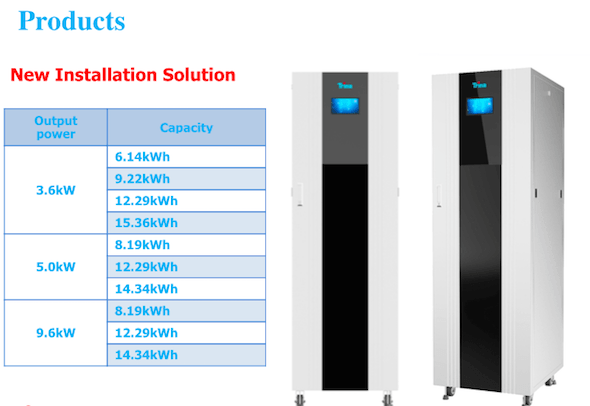Residential Battery Systems (RBS) are the topic of much excitement and speculation in the solar world recently.
Tesla, the electric car giant led by entrepreneur and futurist Elon Musk recently rolled out their new “Powerwall” system to much fanfare. Hot on their heels is Trina, the Chinese solar giant, who announced one week later that they, too will be rolling out a new RBS with a soft launch in Australia this summer. Bosch, GE, LG, Sony and Samsung are all close to releasing similar products.
Both the Tesla and the Trina systems, although very different, are built on a backbone of Lithium Ion batteries. Up until recently, Lead Acid batteries were the only realistic option for RBS because of the high cost of Lithium Ion technology. Now, it would appear that Lithium Ion is ready for prime time in the RBS world. The question is, are Lithium Ion batteries a game changer for solar, or just a stepping stone to the next energy storage technology?
Lithium Ion 101
 Lead-Acid (LA) batteries, similar to those in a car, have long been the only viable option for residential storage when it comes to solar. The cost was relatively affordable, but there are a lot of downsides to lead acid batteries. They require a lot of maintenance, they release gases that must be vented, and they are very heavy. Large Format Prismatic (LFP) Lithium Ion batteries have a lot of advantages, (and a few disadvantages,) over LAs.
Lead-Acid (LA) batteries, similar to those in a car, have long been the only viable option for residential storage when it comes to solar. The cost was relatively affordable, but there are a lot of downsides to lead acid batteries. They require a lot of maintenance, they release gases that must be vented, and they are very heavy. Large Format Prismatic (LFP) Lithium Ion batteries have a lot of advantages, (and a few disadvantages,) over LAs.
- LFP is about one-third the weight of a lead-acid (LA) battery.
- LFPs take up about half the volume of an LA battery with equivalent energy storage
- LAs don’t perform well at low temperatures. LA performance drops by 50% at -4°F, compared to 8% with LFP.
- LA batteries’ discharge voltage tapers as charge decreases.LFP batteries’ voltage remains steady until they are close to being fully discharged.
- Stored LA batteries lose up to 15% of their electrical capacity per month, compared to 1% to 3% for LFPs.
- Wet LA batteries need constant maintenance. LFPs require no additional liquid to maintain their electrolyte levels.
- LA batteries have an average lifespan of about five years; LFP batteries have an estimated longevity of 10 years.
- LA batteries are cheaper up-front than LFPs, their lifetime price per kWh can be higher.
Until recently, the need for a battery management system (BMS) for integrating Lithium Ion batteries has been the limiting factor in their use in renewable energy applications. Tesla, Trina and others are finally tackling that problem, and it appears that LFP batteries for storing solar energy is a market where we will be seeing a lot of action in the next few years.
Are LFP Batteries the Answer?
Right now, Lithium Ion technology is ready for prime time, and appears to be both affordable and scalable. Electronics manufacturers have vast experience with Lithium Ion batteries which currently power everything from mobile phones to cordless power tools. For companies like Bosch and Samsung, scaling up to residential storage is a no-brainer. For the near-term, it looks like there will be a gold-rush in LFP batteries, and despite the hype surrounding Tesla’s Powerwall, the real action appears to be with the tool and electronics giants.
However, like Nickel Cadmium (NiCAD) or Nickel-Metal Hydride (N-MH) batteries (does anyone remember them?) battery technologies come and go. Lithium Ion technology has taken a long time to come to this point, and it is still considered too expensive for many applications.
 Since 2009, a consortium comprising IBM Research and five U.S. Department of Energy National Laboratories (National Renewable, Argonne, Lawrence Berkeley, Pacific Northwest, and Oak Ridge) have hosted an annual symposium at Oak Ridge National Laboratory in Tennessee called “Beyond Lithium Ion.” Held last week, Beyond Lithium Ion VIII featured discussions of Sodium Ion technology, Lithium Air batteries, Lithium Sulphur, Zinc Air, Vanadium Redox Flow batteries, and Liquid Organic Redox batteries (ORBAT.) Of all the various technologies being explored, ORBATs appear to be the most revolutionary, bringing forth a non-toxic technology that requires no precious metals to the world of large-scale energy storage.
Since 2009, a consortium comprising IBM Research and five U.S. Department of Energy National Laboratories (National Renewable, Argonne, Lawrence Berkeley, Pacific Northwest, and Oak Ridge) have hosted an annual symposium at Oak Ridge National Laboratory in Tennessee called “Beyond Lithium Ion.” Held last week, Beyond Lithium Ion VIII featured discussions of Sodium Ion technology, Lithium Air batteries, Lithium Sulphur, Zinc Air, Vanadium Redox Flow batteries, and Liquid Organic Redox batteries (ORBAT.) Of all the various technologies being explored, ORBATs appear to be the most revolutionary, bringing forth a non-toxic technology that requires no precious metals to the world of large-scale energy storage.
None the less, while we wait for ORBATs to become a reality, Lithium Ion technology is where the action is for the near future, and consumers are enthusiastic. While non-standardized BMSs may keep total system costs high, the actual price of Lithium Ion storage is expected to fall 50% in the next 5 years, according to executives at LG.
Reference: Home Power





